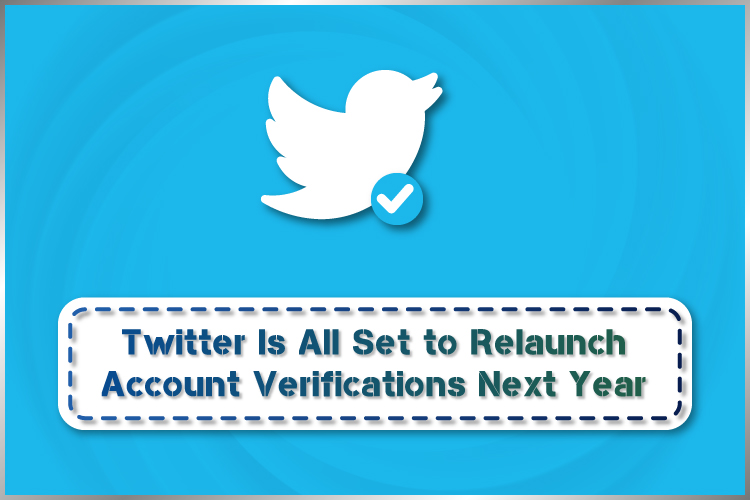

After holding back the account verification process for more than three years now, every social media lover’s favorite app to express their takes publicly, Twitter is now ready to relaunch public verifications early next year.
The popular social network has announced that they are officially planning to bring back the account verifications program in early 2021; however, the relaunch will be accompanied by a significant revamp to the process.
Taking a trip down memory lane, Twitter had set the platform on fire after it verified the account of Jason Kessler, who was one of the organizers of the Charlottesville rally, back in 2017. It received instant backlash from the infuriated users. Later Twitter Support account sent out a tweet clarifying that their action of verifying the account was in no way meant to support its tweets. But some users seem to have taken it the wrong way, while the blue verified badge is just meant to portray the authenticity of an account of public interest. The company acknowledged their contribution to creating this confusion and decided to suspend all their account verifications until they resolve this.
Well, we guess now they are ready to do so. The company intends to reintroduce the program early next year, which provides them with ample time to collect feedback from users about how they should handle the public verification process in order to update their new policy. Twitter has stated this clearly in their recent official announcement.
The platform has also presented the very first draft of their new account verifications policy before the users, identifying the six types of accounts that are eligible to be verified on Twitter.
Types of Accounts That Qualify for Verification
Here are the six types of user accounts that qualify for verification:
- Government
- Companies, Brands, and Organizations (including Non-Profit Organizations)
- News
- Entertainment
- Sports
- Activists, Organizers, and other influential individuals
The criteria for getting verified and receiving a blue badge on Twitter is pretty simple – your account should be notable and active, as the company mentions in its new policy’s initial draft. While falling into one of these aforementioned account categories defines your notability, being active on the platform means your account should fulfill these criteria:
- It should be complete, which means it must have your profile name, bio, and profile and cover picture.
- You must have logged in to your Twitter account at least once in the last six months.
- It should have your confirmed email address or phone number.
- It should not have been found in violation of Twitter rules or received a 12 hours or 7 days lockout in the last six months duration for the same. However, successful appeals are an exception in this case.
Types of Accounts That Don’t Qualify for Verification
Twitter has also made it clear that what types of accounts won’t qualify to get verified. Any account that meets any one or more of these criteria will be considered ineligible for verification:
- Parody, commentary, newsfeed, and fan accounts
- Representing a pet or fictional character (unless the account is associated with a verified entertainment production house or recognized brand, company, or organization)
- Engagement of the account in severe contraventions of Twitter’s Platform Manipulation and Spam policy (for example, sale or purchase of followers)
- Accounts representing groups or individuals affiliated with coordinated harmful activities or hateful content
Accounts That Might Lose Their Verification Status
Last but not least, Twitter holds the authority to cancel an account’s verification status and remove their blue verified badge at any time without even giving notice if they are found to be doing any one of these:
- If the account changes their Twitter handle or becomes incomplete or inactive
- The individual no longer holds the position for which they were initially verified or no longer meets the platform’s verification criteria
- The account is impersonating or misleading people on purpose by changing their bio or display name
- If the account is found to committing serious contraventions that lead to immediate account suspension
- The account is repeatedly posting tweets that violate Twitter guidelines
However, the policy also clarifies that the cancellation of the verified status won’t be made automatically; instead, it will be evaluated on a case-by-case basis.
Conclusion
This is only the initial draft of Twitter’s new verification policy, and the company has shared it to receive feedback from the public. Therefore, the policies and rules mentioned in this post might change before the platform publishes the final copy.
Anyone can submit their feedback by either participating in their official survey or simply tweeting their feedback using the hashtag #VerificationFeedback. The company said they would be closely monitoring this hashtag to see what their audience thinks about this new policy. The public feedback period will last for about two weeks before the company reviews all the feedback and introduces the final policy. Users will be able to apply for their account verification from the next year.
So go ahead and share your thoughts on this with Twitter!
Hariom Balhara is an inventive person who has been doing intensive research in particular topics and writing blogs and articles for Tireless IT Services. Tireless IT Services is a digital marketing, SEO, SMO, PPC, and web development company that comes with massive experiences. We specialize in digital marketing, web designing and development, graphic design, and a lot more.
SOURCE : Twitter Is All Set to Relaunch Account Verifications Next Year



























